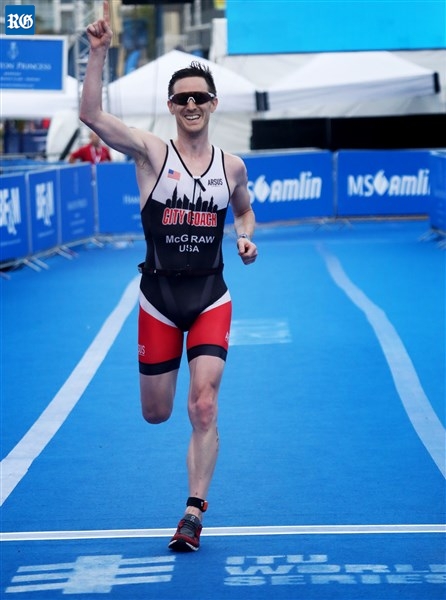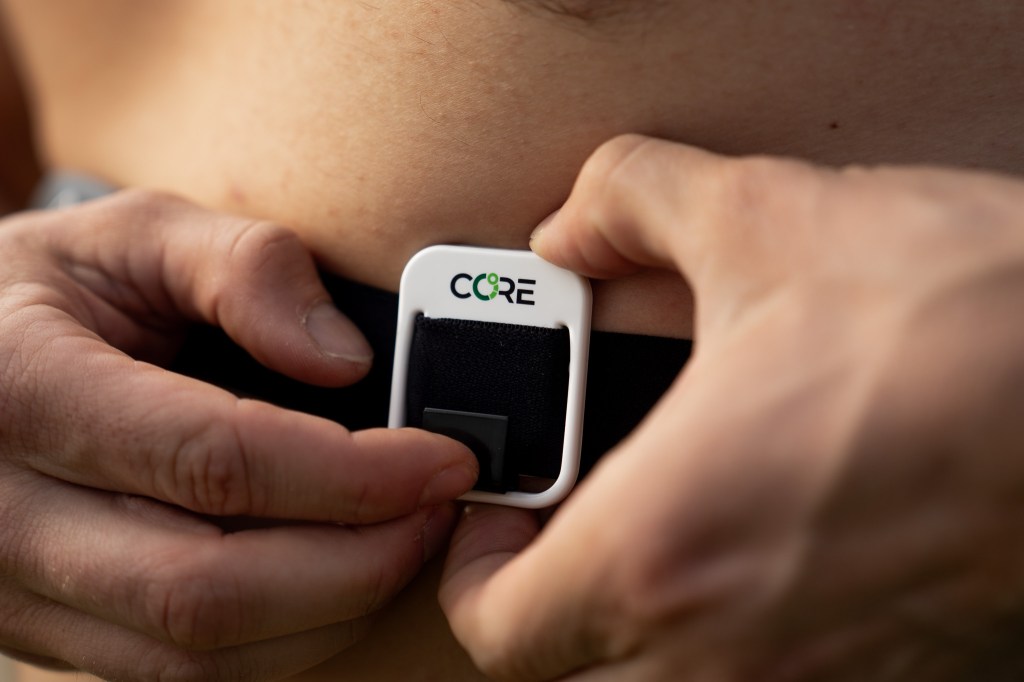Stuff Meets… professional triathlete and CORE’s VP and Global Head: Ross McGraw
New York City based Ross McGraw talks about CORE athletes headed to the Olympics, making the body temperature sensor assessable for all, his own professional sporting career and being fascinated with how tech interfaces with culture…

We make a core body temperature sensor
It’s the only non-invasive continuous option for monitoring body temperature – that’s quite important, especially within the sports space, where CORE is really invested because humans are rather inefficient. So, for every roughly 20% you put into the pedals or when you’re running you’ve got roughly 80% that needs to be dissipated through heat and what tends to happen is when it’s really hot outside of course that’s one factor but humans generate, when they are putting out this power, quite a bit of heat themselves and once they hit their threshold then your pace/pace starts to decline quite rapidly. So, for an athlete, this is a huge issue.

Athletes are using the technology in different ways
So, just as you’d do an altitude camp, instead you can get on your treadmill in your basement which is a lot more assessable than two weeks in Tenerife, or whatever – we can’t all do this. You can do focused heat sessions and get some physiological adaptations and similar to altitude training, get some performance gains, even in cooler weather because you increase your hemoglobin mass and plasma volume – so your red blood cells that carry more oxygen and you can go faster. With the Tour de France and the Olympics athletes are doing this for performance but also to be ready for the heat. The other way athletes are using CORE is during activities, or even before is trying to bring their core temperature down so they can perform better.
We started Core in the research performance space
For that reason, most of our users were sports scientists or researchers or riders on the Tour who have three coaches and all of these people around them. We could be purely data driven and say ‘here’s the raw data’ essentially and they would digest it, so with the new app update what we are trying to do is bring this technology towards a wider audience. What we also learned is that those athletes who worked with the coaches – they were just wearing it and then the coach would tell them what to do – they wouldn’t even see the data or really see what was happening… That was a barrier to the coaches getting the athletes to use it.
We created Heat Strain Index – previously you had to look at your core temp and the ambient temperature skin temp because, just like a car, if the engine is running and it’s cold out that’s pretty good but if the engine running and it’s hot out it’s a very different thing. So, we came up with an index that really puts that together into one metric, so 1 to 10 of how high the strain is. Let’s say of the conditions you’re in and then we also did is subdivided that by zones. So it was only one you’ve got all your power so into your starting to lose power maybe you think about cooling down a little bit or if your heat training maybe you’re starting to get some of those adaptation benefits over time and then zone three – that’s where you really start to lose power it’s also ironically where you get the most gain if you’re doing heat training and then for is red so we kind of all intuitively know what that means don’t go there and certainly don’t go there without checking with it medical professional.
What that means is that now individuals at home can put together the building blocks. I can look after an activity of how much heat strain I’ve had, and then my adaptation score will go up. And what you learned is after maybe two weeks of intensive sessions, I’ve got into maybe over 90%, and to maintain that takes much less. Maybe it’s two sessions a week. So, it allows even somebody who’s not a sports scientist to start getting these gains in these benefits and to start better pacing in races and events.
Some of our athletes are headed for the Olympics
Kristian Blummenfelt, I was with him yesterday, he’s headed to Paris as the defending gold medallist in triathlon. The Norwegians in general, Gustav Iden, his teammate isn’t going this year but is the defending Kona record holder and Ironman World champion.
We have quite a mix – we have some rowers, anything in the endurance sport. Ross Corrigan is one of the Irish rowers – he’s a World Champion Bronze Medallist and Fintan McCarthy, also a lightweight rower. Both finished first in the heat’s of the men’s lightweight double scull, and men’s pair, respectively with their teams, and are heading to the semifinals.
We’ve got a really interesting mix and then within cycling, we have roughly two thirds of the World Tour Peloton and Tour de France using it. If you look at the cross section of athletes that will be riding in the Olympics, it’s essentially the same people, minus a few and plus a few, but obviously there’s quite a few athletes who we work with there.
I’m a semi-retired pro-athlete
I used to run in college and university – our team was quite good, but I was never going to make it anywhere big. While I was working in the media space, at Paramount, I found some free time to go get my licences as an Ironman and USA Triathlon triathlete and train professionally for a little bit – which is how I discovered some of this!

I was actually heat training and I didn’t know it. So, when I was still in amateur I would do my indoor sessions – we had a newborn son, so I would get up at 4am, feed him, get on the bike trainer, then I would bike up to the pool and do a master swim session, bike back and spend the morning doing breakfast, bike to work and then at midday I would do like a recovery session. In the evening, I would come back and do a weight training session, go to bed, do the same thing again… And the trainer sessions, because I had limited time, I would do them on my bike trainer indoors in city apartment right next to the radiator, because that was the space we had. I had the fastest bike split at Worlds in Rotterdam when I was still an amateur at that point, which didn’t make a lot of sense. You know, usually the bigger guys on flatter courses do quite well and there was no indication in my numbers that I was looking at that I was going to win. But what I realised in retrospect, as I was doing quite a bit of heat training and Rotterdam was rather cool. So, I had all of this increased capacity that I was able to use there, which is very, very interesting. Within the running community it was sort of a known thing that they say – humidity or the poor man’s altitude!
I got a job at Hammerhead while looking for sponsors for my triathlon habit, which is rather expensive
I discovered this company making a bike GPS computer, and I reached out. It was like, maybe they’ll give me one and they wrote back and they said, well, we don’t have any yet – it’s not really yet – but we do need someone to run sales and marketing revenue. I looked them up and they weren’t very well known at this point, in fact, most people had no idea and I figured I couldn’t really fail it that making them less known… It was rather successful – two and a half years later we sold that company to SRAM, one of the biggest bike component manufacturers in the world. And that’s one of the ways I met Wolf, the CEO of Greenteg who founded Core.
I like to ride my bike and do silly things…
Last year, during the Tour de France – we had a bunch of teams in it – so we went over, took the train to Geneva. I brought my bike, and I would ride with my friends all day basically through the Tour route and would we pick a spot, watch the race and ride all the way home. We would have family meet us for lunch – my wife is a travel writer – she actually launching a bag line at the Olympics because she came up with this idea of a travel inspired sort of bag for parents. So, between the two of us generally we’re just hopping all over the world and doing all kinds of interesting things. My son has grown up used to this – I like to say he has no chill, but maybe this is a family trait to be honest.
I’m fascinated by how tech interfaces with culture
What’s really interesting to me is technology is generally way further ahead than our ability to accept it. Even things like electric cars – the biggest challenge we thought was infrastructure and then the infrastructure gets built and we make better batteries, and we do all these things, and the technology is amazing, but then you have this habitual thing where people can’t quite break their schedule to say I need to charge a car and I can’t drive, I need to take a break and charge. So, it’s that’s kind of what I’m always fascinated with.
Find out more about CORE here.


